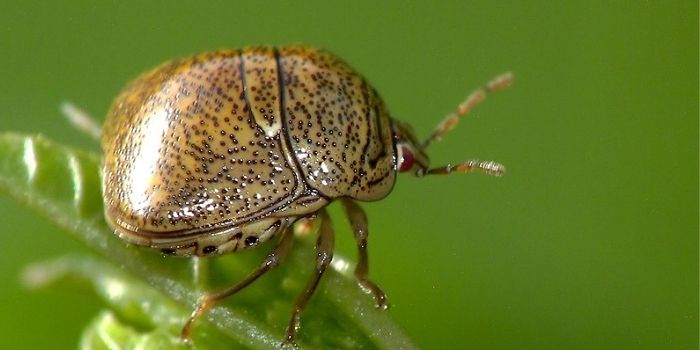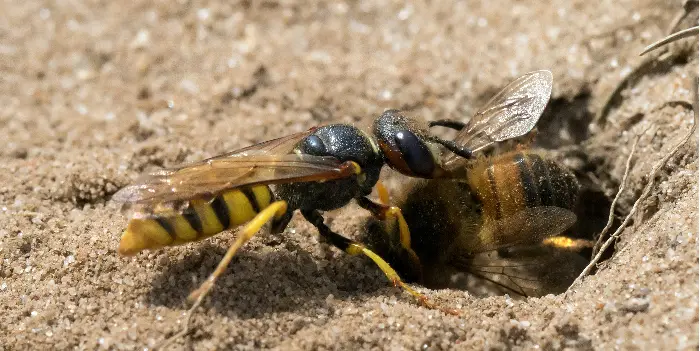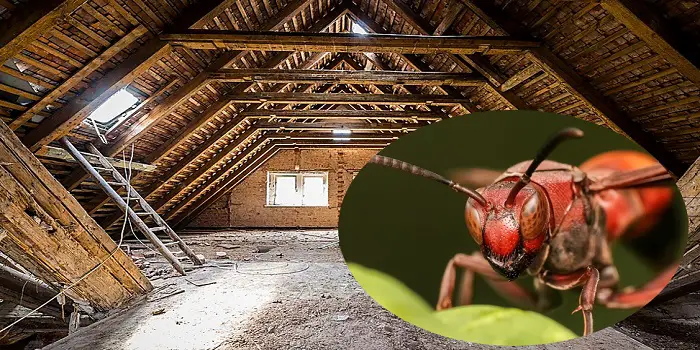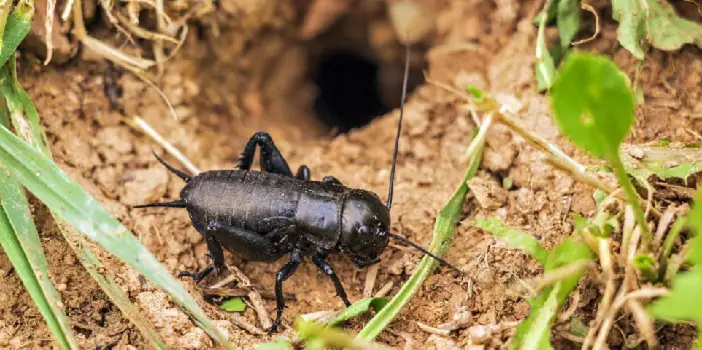
Kudzu bugs get their name from the plant they like to eat, “kudzu.”
This plant is native to various locations in Asia but has turned up in the Southeastern United States as an invasive species.
Although not dangerous for humans (regarding health), Kudzu bugs can be a major nuisance for homeowners, gardeners, and farmers because they are a group of pests for crops and particularly like to feed on legumes like soybeans.
Moreover, if the bug gets crushed, it emits an odor and can stain the surface where it was killed.
How do you identify them?
The Kudzu bug is tiny, measuring only 1/8 to 1/4 of an inch when fully grown— roughly the size of a ladybug.
The insect also has an oblong body that is green with specks of brown.
What are they attracted to?
Kudzu bugs are also attracted to light-colored areas such as white cars, white house siding, and white fabrics.
While inactive in winter, they can be seen in the cracks in the siding of houses, around windows, and in the crannies of trees.
They can be noticed most prominently during two different times of the year, including early spring when they come back from hibernating as well as autumn when they hang out in sunny areas to stay warm.
Ways To Get Rid of Kudzu Bugs
Kudzu bugs are more likely to be noticed in areas where legumes and Kudzu are prominent, as these are their favorite foods.
Areas where soybeans are grown are especially susceptible to Kudzu bug infestations.
Moreover, these bugs will try to go indoors through cracks, screens, and other such openings to stay warm during winter.
Keeping them controlled can be a frustrating experience because of their staining and odor. But you can try these methods to get rid of them…
1- Manual Removal
If you have Kudzu bugs in your house, you can vacuum them up using a hose attachment and then throw out the vacuum bag.
The bag can be submerged in hot soapy water or put in the freezer to eliminate the insects, but be sure you don’t crush them!
2- Spray Adult Kudzu Bugs
Different household pesticides can be used to kill Kudzu, though they can be challenging to rely on since these insects stay high up on walls.
If you spray them, be sure to use a pyrethrin-based pesticide like bifenthrin, permethrin, or lambda-cyhalothrin.
When you use these products outside, try not to let the pesticide get caught in the wind.
If you spray overhead, take precautions to stop the pesticide from getting on your skin or in your eyes.
Take care not to allow the product into storm drains or other runoff areas, as the chemicals are toxic to aquatic animals.
3- Do Not Ignore the Nymphs
Though spraying for Kudzu bugs occurs in the autumn when adults are looking for hiding places to stay warm in the winter, it may be more effective to spray the plants that are vulnerable to their infestations earlier in the year to get rid of the nymphs while they feed.
This method is used commonly in commercial agriculture to protect crops like soybeans.
Homeowners may also benefit from spraying vulnerable plants at this time, like green beans or wisteria, while the nymphs are still hatching.
The nymphs are fuzzy, tiny insects that have a yellow color and congregate on stems and leaves.
Spraying the vulnerable plants thoroughly while new generations of nymphs arise will help prevent the adults from cropping up and invading your home.
Spraying a home might not be as effective if any nearby soybean fields or kudzu are not also treated similarly.
4- Call an Exterminator
A professional exterminator might be the best choice if you have difficulty controlling the insects.
Exterminators will have the pesticides and tools needed to spray your home all the way up to the roof.
Several treatments each week might be necessary to completely control the insects in the fall.
Tips for Preventing Kudzu Bugs in the Garden
Kudzu bugs tend to show up wherever their food sources are. Removing invasive Kudzu from areas nearby can help reduce their populations.
Wisteria vines and legumes are also common foods for the bugs, so plants like beans and peas should also be removed.
By avoiding having these plants around, you may be able to lessen the total population in your local area.
To stop the insects from coming into your home, seal all gaps on the outside of the house, such as around doors and windows, pipe openings, vents, and the foundation.
Painting the house a darker hue might also help to this end since these bugs prefer light-colored surfaces to darker ones.

What Other Pests Can Eat Beans and Legumes?
Green beans, sometimes also known as snap beans, are prone to attracting various insects (including kudzu bugs) that eat and make holes through them.
These bugs can be anything from large caterpillars to tiny mites, and the range of culprits could make it difficult to figure out what’s going after yours.
Once you know what to look for, you can figure out which insect is attacking your green beans and their buds so that you can get rid of them sooner.
1- Sap Suckers
Aphids, thrips, whiteflies, and spider mites are all sap suckers that use their mouths to pierce parts of the plant and then suck the juices out of it.
This feeding can result in small leaf holes appearing in the plants and premature leaf dropping, distortion, discoloration, and poor crop yield.
Spraying the green bean plants down with a burst of water will usually knock these pests away from the plants.
You could also use contact insecticide that is not as toxic as some, such as insecticidal soap or neem oil.
The plants can be sprayed in seven to 10-day intervals to keep the pests at bay.
2- Biting Bugs
Darkling beetles, cucumber beetles, stinkbugs, bean weevils, and Lygus bugs are insects that could eat holes in the plants.
You can control these bugs through care and good sanitation.
Remove debris and weeds from around the green bean plants, as these offer hiding places for the bugs.
Remove any excessive organic material like mulch, as this can serve as a place for darkling beetles’ larvae.
Furthermore, keep an eye on any green bean plants to find weevils, beetles, and other such insects.
Discard them and their eggs when you find them using paper towels to crush them.
3- Chewing Caterpillars
These are the larval states of butterflies and moths that lay their eggs on plants such as green bean plants.
After they hatch, they start feeding on the plant, which is in chewed stems and leaves.
This can cause the plants to defoliate and lessen the crop yield. In extreme cases, the plants could even die.
Leaf miners, armyworms, and cutworms are common chewing caterpillars that attack green bean plants, while corn earworms and lycaenid pod borers burrow into the bean pods to eat the seeds.
You can control these caterpillars by removing them by hand and discarding them in soapy water.
You can also dilute four teaspoons of Bacillus thuringiensis insecticide in a gallon of water and then spray the plants.
4- Slimy Insects
Slugs and snails are nocturnal, and they eat the pods, stems, and leaves of green bean plants.
They hide during the day and then show up after the sun sets to eat the veggies.
If you find any green bean plants with silvery trails, you can feel confident that snails or slugs have come to eat them.
You can control them by avoiding overwatering the plants, as excessive moisture will attract them.
You can also place copper banding around the plants to stop the bugs from getting into the area.
The bands will react to the mucus that the snails and slugs excrete, generating a harmless electrical shock that will stop them from climbing over them.
5- Larger Animals
When the buds of green beans disappear, you can blame certain animals.
Mammals like rabbits, squirrels, and deer like to munch on the little buds, and you can try to keep them out by fencing the garden, including the top of it.
You can also put a fair layer of lime around the plants to find footprints and to also create the best fence.
6- Lygus Bugs
These bugs can be identified by their greenish-brown bodies and a yellow triangle on their backs.
They enjoy green beans more than most other kinds of plants but can be stopped by getting rid of weedy hiding areas near the garden.
The adults like to hang out in plant debris and then lay their eggs.
When the eggs hatch, the larvae will also feed on the buds. Spray insecticide on all of the plant surfaces to get rid of the nymphs once a week.
7- Corn Earworms
Slow bud-eating over time can indicate that there are corn earworms nearby.
Though their name suggests they like corn, they target the leaves, flowers, and green bean buds.
You can pick these pests off of the plant yourself or treat them using Bacillus thuringiensis insecticide by mixing four teaspoons with a gallon of water and then spraying them.
Not only will this kill the corn earworms, but it will also target any other pod-boring bean insects to help you deal with any other pests you might not have yet identified.
The Conclusion
It can be frustrating to go into the garden every day and see that pests have gotten into your green beans or green bean buds.
Above, we listed a few of the most common offenders who enjoy snacking on beans and buds, how to identify them for yourself, and a few days to handle them to prevent this.
Hopefully, you can now protect your beans and legumes better.
Share the post "Why are Kudzu Bugs Bad – How to Remove Them from Your Plants?"

Welcome to ProShieldPest.com. I am Tina Jones. I have been working as a pest removal professional in Winslow, Arizona lately. At present, I love to spend my time with my family as a retiree.
Here I share all my knowledge and experiences to help people understand better how they can stop pests at their homes without actually killing them. Hopefully, the information you will find here will help in safeguarding your home! You can check more about me here.




